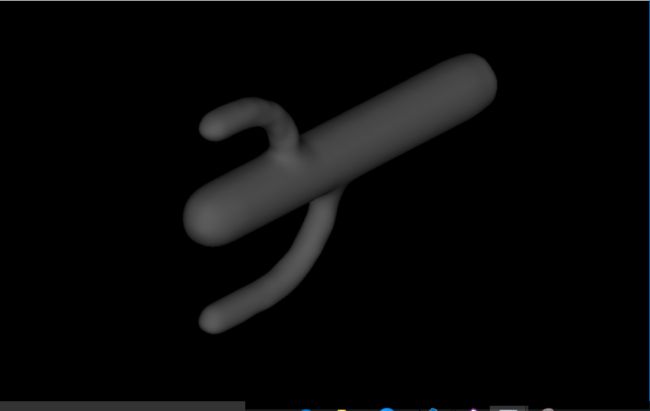opengl | openmesh 读取显示3d模型文件
操作
鼠标控制物体旋转移动,滚轮缩放
F1,F2,F3 可以更换显示文件 (file1:cow.obj file2:cactus.ply file3 : Armadillo.off)
F4 更换显示模式 (wire,flat,flatlines)
截图
使用命令行显示当前状态
准备
openmesh的下载配置
- 下载最新的安装包
- 安装openmesh
配置vs
- 工具-》选项-》项目和解决方案-》VC++目录 配置 包含文件和库文件,分别是openmesh\include和openmesh\lib两个路径(比如:加C:\Program Files (x86)\OpenMesh 2.3\include和C:\Program Files (x86)\OpenMesh 2.3\lib目录)
- 在所建工程上右键-》属性-》预处理器-》预处理器定义添加_USE_MATH_DEFINE,同时在连接器-》输入-》附加依赖性中添加OpenMeshCored.lib和OpenMeshToolsd.lib
- 在我的配置时,还出现了一个问题就是:报错 1>c:\program files (x86)\microsoft visual studio11.0\vc\include\xutility(2176): error C4996: ‘std::_Copy_impl’: Function callwith parameters that may be unsafe - this call relies on the caller to checkthat the passed values are correct. To disable this warning, use-D_SCL_SECURE_NO_WARNINGS. See documentation on how to use Visual C++ ‘CheckedIterators’ 这个的解决也是在预处理器重添加 _SCL_SECURE_NO_WARNINGS
openmesh使用和3d文件的原理
添加头文件即可:
#include // 读取文件
#include // 操作文件 mesh中3个关键元素:Face 面,Edge 边,Vertex 顶点
我们在绘图中就是遍历mesh文件中的这三种数据绘制的
具体可点击查看此链接
制作
第一步:读取文件
读取文件代码如下:
// 读取文件的函数
void readfile(string file) {
// 请求顶点法线 vertex normals
mesh.request_vertex_normals();
//如果不存在顶点法线,则报错
if (!mesh.has_vertex_normals())
{
cout << "错误:标准定点属性 “法线”不存在" << endl;
return;
}
// 如果有顶点发现则读取文件
OpenMesh::IO::Options opt;
if (!OpenMesh::IO::read_mesh(mesh, file, opt))
{
cout << "无法读取文件:" << file << endl;
return;
}
else cout << "成功读取文件:" << file << endl;
cout << endl; // 为了ui显示好看一些
//如果不存在顶点法线,则计算出
if (!opt.check(OpenMesh::IO::Options::VertexNormal))
{
// 通过面法线计算顶点法线
mesh.request_face_normals();
// mesh计算出顶点法线
mesh.update_normals();
// 释放面法线
mesh.release_face_normals();
}
}这个文件读取看起来比较繁琐,但是对比网上其他实现读取的方法,我觉的这样写文件读取更加安全一些
第二步:显示
这里我使用了 显示列表 (Display list)进行显示, 关于显示列表是什么,怎么用,可以阅读以下的博客链接: link
其主要优势就是 可以优化程序的性能
//初始化顶点和面
void initGL()
{
glClearColor(0.0, 0.0, 0.0, 0.0);
glClearDepth(2.0);
glShadeModel(GL_SMOOTH);
glEnable(GL_DEPTH_TEST); //用来开启深度缓冲区的功能,启动后OPengl就可以跟踪Z轴上的像素,那么它只有在前面没有东西的情况下才会绘制这个像素,在绘制3d时,最好启用,视觉效果会比较真实
// ------------------- Lighting
glEnable(GL_LIGHTING); // 如果enbale那么就使用当前的光照参数去推导顶点的颜色
glEnable(GL_LIGHT0); //第一个光源,而GL_LIGHT1表示第二个光源
// ------------------- Display List
showFaceList = glGenLists(1);
showWireList = glGenLists(1);
int temp = mesh.n_edges();
// 绘制 wire
glNewList(showWireList, GL_COMPILE);
glDisable(GL_LIGHTING);
glLineWidth(1.0f);
glColor3f(0.5f, 0.5f, 0.5f);
glBegin(GL_LINES);
for (MyMesh::HalfedgeIter he_it = mesh.halfedges_begin(); he_it != mesh.halfedges_end(); ++he_it) {
//链接这个有向边的起点和终点
glVertex3fv(mesh.point(mesh.from_vertex_handle(*he_it)).data());
glVertex3fv(mesh.point(mesh.to_vertex_handle(*he_it)).data());
}
glEnd();
glEnable(GL_LIGHTING);
glEndList();
// 绘制flat
glNewList(showFaceList, GL_COMPILE);
for (MyMesh::FaceIter f_it = mesh.faces_begin(); f_it != mesh.faces_end(); ++f_it) {
glBegin(GL_TRIANGLES); //三角形模式
for (MyMesh::FaceVertexIter fv_it = mesh.fv_iter(*f_it); fv_it.is_valid(); ++fv_it) {
glNormal3fv(mesh.normal(*fv_it).data());
glVertex3fv(mesh.point(*fv_it).data());
}
glEnd();
}
glEndList();
}halfeage其实就是有向的边,吧所有的有向边的头尾链接起来就是网格了
face 更好画,使用绘制三角形的模式直接绘制每一个面就可以了
在以上文件中,我将绘制了面和网格的模式。在显示的时候,我会调用 glcalllist(list) 具体制定显示哪一个显示列表
第三步:良好的交互
在使用meshlab的过程中,可以可以用鼠标移动其中的物体角度,滚轮放缩
// 鼠标交互
void myMouse(int button, int state, int x, int y)
{
if (button == GLUT_LEFT_BUTTON && state == GLUT_DOWN) {
mousetate = 1;
Oldx = x;
Oldy = y;
}
if (button == GLUT_LEFT_BUTTON && state == GLUT_UP)
mousetate = 0;
//滚轮事件
if (state == GLUT_UP && button == 3) {
if (currentfile == 3)
scale -= 0.002;
else
scale -= 0.1;
}
if (state == GLUT_UP && button == 4) {
if (currentfile == 3)
scale += 0.002;
else
scale += 0.1;
}
glutPostRedisplay();
}
// 鼠标运动时
void onMouseMove(int x, int y) {
if (mousetate) {
//x对应y是因为对应的是法向量
yRotate += x - Oldx;
glutPostRedisplay();
Oldx = x;
xRotate += y - Oldy;
glutPostRedisplay();
Oldy = y;
}
}以上函数在鼠标每次按住移动后,记录了当前位置相对于一开始按下点的移动位置,并转化为物体应该旋转的角度。滚轮事件也通过改变scale的大小来改变物体的缩放比
其他
以上就是要用到的主要技术:你还可以通过设定键盘事件来快速的更换显示文件,和显示模式等
还有一个略坑的东西就是最后一个文件极大,所以在更换文件为 file3 之后,要改变 scale 和 滑轮 滚动的缩放改变 到对应大小
全部代码
#include
#include
#include
#include "GL\glut.h"
#include (w), static_cast(h));
glMatrixMode(GL_PROJECTION);
glLoadIdentity();
if (w > h)
glOrtho(-static_cast(w) / h, static_cast(w) / h, -1.0, 1.0, -100.0, 100.0);
else
glOrtho(-1.0, 1.0, -static_cast(h) / w, static_cast(h) / w, -100.0, 100.0);
glMatrixMode(GL_MODELVIEW);
glLoadIdentity();
}
// 读取文件的函数
void readfile(string file) {
// 请求顶点法线 vertex normals
mesh.request_vertex_normals();
//如果不存在顶点法线,则报错
if (!mesh.has_vertex_normals())
{
cout << "错误:标准定点属性 “法线”不存在" << endl;
return;
}
// 如果有顶点发现则读取文件
OpenMesh::IO::Options opt;
if (!OpenMesh::IO::read_mesh(mesh, file, opt))
{
cout << "无法读取文件:" << file << endl;
return;
}
else cout << "成功读取文件:" << file << endl;
cout << endl; // 为了ui显示好看一些
//如果不存在顶点法线,则计算出
if (!opt.check(OpenMesh::IO::Options::VertexNormal))
{
// 通过面法线计算顶点法线
mesh.request_face_normals();
// mesh计算出顶点法线
mesh.update_normals();
// 释放面法线
mesh.release_face_normals();
}
}
// 键盘交互 1. 切换文件 2.切换显示
void mySpecial(int key, int x, int y) {
switch (key) {
case GLUT_KEY_F1:
cout << "读取文件:" << file_1 << " 中......" << endl;
readfile(file_1);
scale = 1.0;
currentfile = 1;
initGL();
break;
case GLUT_KEY_F2:
cout << "读取文件:" << file_2 << " 中......" << endl;
readfile(file_2);
scale = 1.2;
currentfile = 2;
initGL();
break;
case GLUT_KEY_F3:
cout << "读取文件:" << file_3 << " 中......" << endl;
readfile(file_3);
scale = 0.01;
currentfile = 3;
initGL();
break;
case GLUT_KEY_F4:
if (showFace == true) {
showFace = false;
showWire = true;
cout << "切换显示模式为:WireFrame" << endl;
}
else if (showWire == true)
{
showWire = false;
showFlatlines = true;
cout << "切换显示模式为:Flatlines" << endl;
}
else if (showFlatlines == true) {
showFlatlines = false;
showFace = true;
cout << "切换显示模式为:Flat" << endl;
}
break;
case GLUT_KEY_UP:
ty += 0.01;
break;
case GLUT_KEY_DOWN:
ty -= 0.01;
break;
default:
break;
}
glutPostRedisplay();
}
// 鼠标交互
void myMouse(int button, int state, int x, int y)
{
if (button == GLUT_LEFT_BUTTON && state == GLUT_DOWN) {
mousetate = 1;
Oldx = x;
Oldy = y;
}
if (button == GLUT_LEFT_BUTTON && state == GLUT_UP)
mousetate = 0;
//滚轮事件
if (state == GLUT_UP && button == 3) {
if (currentfile == 3)
scale -= 0.002;
else
scale -= 0.1;
}
if (state == GLUT_UP && button == 4) {
if (currentfile == 3)
scale += 0.002;
else
scale += 0.1;
}
glutPostRedisplay();
}
// 鼠标运动时
void onMouseMove(int x, int y) {
if (mousetate) {
//x对应y是因为对应的是法向量
yRotate += x - Oldx;
glutPostRedisplay();
Oldx = x;
xRotate += y - Oldy;
glutPostRedisplay();
Oldy = y;
}
}
void myDisplay()
{
//要清除之前的深度缓存
glClear(GL_COLOR_BUFFER_BIT | GL_DEPTH_BUFFER_BIT);
glLoadIdentity();
//与显示相关的函数
glRotatef(xRotate, 1.0f, 0.0f, 0.0f); // 让物体旋转的函数 第一个参数是角度大小,后面的参数是旋转的法向量
glRotatef(yRotate, 0.0f, 1.0f, 0.0f);
glTranslatef(0.0f, 0.0f, ty);
glScalef(scale, scale, scale); // 缩放
//每次display都要使用glcalllist回调函数显示想显示的顶点列表
if (showFace)
glCallList(showFaceList);
if (showFlatlines) {
glCallList(showFaceList);
glCallList(showWireList);
}
if (showWire)
glCallList(showWireList);
glutSwapBuffers(); //这是Opengl中用于实现双缓存技术的一个重要函数
}
int main(int argc, char** argv)
{
glutInit(&argc, argv);
glutInitDisplayMode(GLUT_RGB | GLUT_DOUBLE | GLUT_DEPTH); // GLUT_Double 表示使用双缓存而非单缓存
glutInitWindowPosition(100, 100);
glutInitWindowSize(800, 500);
glutCreateWindow("Mesh Viewer");
//一开始默认读取文件1
readfile(file_1);
initGL();
glutMouseFunc(myMouse);
glutMotionFunc(onMouseMove); // 鼠标移动的时候的函数
glutSpecialFunc(&mySpecial);
glutReshapeFunc(&myReshape);
glutDisplayFunc(&myDisplay);
glutMainLoop();
return 0;
} 




